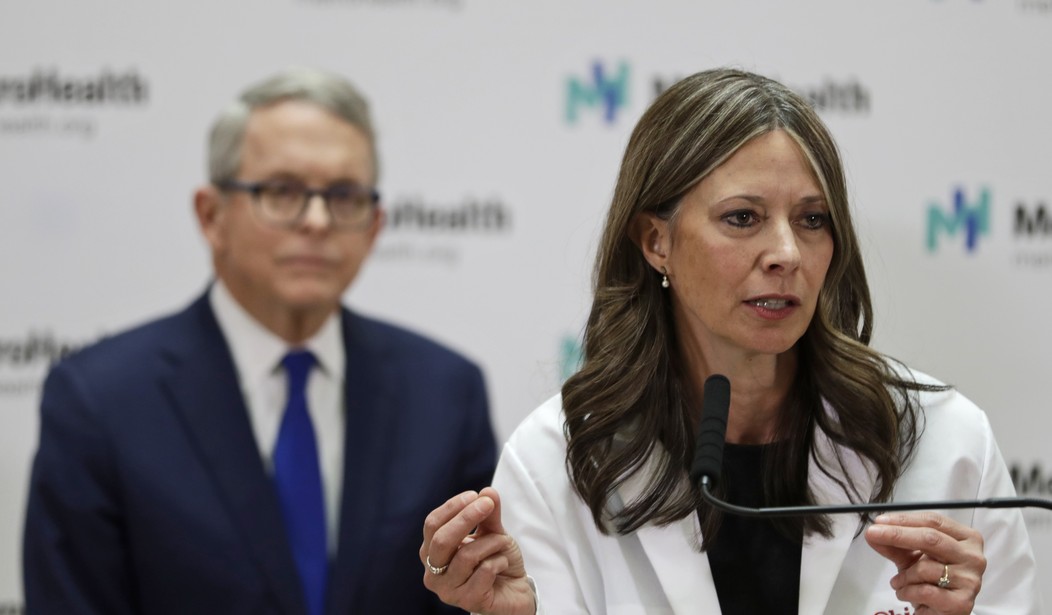The Ohio Department of Health is dragging its feet on an Ohio public records request from a public policy group seeking information about models used by the health director to make decisions related to the state’s COVID-19 response. In delaying the request, the health department cited an obscure passage tucked into a bill passed in March and signed into law by Governor Mike DeWine, which they say allows them to delay records requests until 90 days after the current state of emergency is lifted. Senate Leader Larry Obhoff says they’re misinterpreting the language and improperly denying the request.
In April, the Ohio Roundtable, a division of the American Policy Roundtable, filed a Freedom of Information request with Dr. Amy Acton, who was the director of health at the time. The purpose of the request, according to the nonpartisan public policy group, “is to permit all Ohioans to ‘see the math’ behind the construction of Dr. Acton’s latest model, which is controlling public policy decisions in Ohio,” including mandatory business and school closures and stay-at-home orders.
DeWine and officials at the Ohio Department of Health have been under fire in recent months for what many consider to be their heavy-handed approach to the virus and the lack of transparency coming from state government about how decisions that affect the lives of 11.69 million Ohioans are being made.
“From the start of this crisis, Dr. Acton’s models have driven public policy in Ohio,” said Rob Walgate, vice president of the American Policy Roundtable, in an April 3 press release. “These policies are now creating tremendous hardships across the state at every level. Unemployment is skyrocketing, civil liberties are evaporating, people are being spied upon, harassed and threatened with arrest for standing too close to each other.”
“While promising transparency, Dr. Acton has openly admitted to ‘guesstimating’ on her numbers,” he added. “Now, her latest model is buried in secrecy at Ohio State University and no one is permitted to see the math.” The lack of transparency led the organization to file a formal records request, which, by law, must be fulfilled “promptly” and within “a reasonable period of time.”
But that’s not what happened. Instead, Robert M. Laubert, senior counsel for the Ohio Department of Health, sent a letter to the Roundtable saying he could not provide the group with a “realistic estimate” for when the request might be fulfilled. He said that state employees being required to work from home “may result in a delay” in processing the request.
Further, he said a provision in a bill passed at the end of March “had the effect of extending the deadline by which the Department of Health must respond to all of the public records requests it receives under section 149.43 of the Ohio Revised Code.”
“The new deadline is now 90 days after the state of emergency declared by Governor DeWine is lifted, or December 1, 2020, whichever date occurs first,” the health department’s attorney wrote. He assured the Roundtable that the department has “no intention of waiting that long” to fulfill the request and promised to provide the group with the records they are requesting “as quickly as possible.”
Today marks three full months since the Roundtable sent its records request to the health department. Walgate told PJ Media that they’re still waiting for the state of Ohio to “show their math.”
The section of the Ohio Revised Code Laubert cited was included on page 326 of the 350-page Am. Sub. H. B. No. 197, which became law on March 27. It states:
(B) If a state agency is required by law to take action during the period of the emergency declared by Executive Order 2020-01D, issued March 9, 2020, but not beyond December 1, 2020, if the period of the emergency continues beyond that date, notwithstanding the date by which action is required to be taken in accordance with that law, the state agency shall take that action not later than the earlier of either ninety days after the date the emergency ends or December 1, 2020.
Ohio Senate President Larry Obhof, who has read the letter sent to the Roundtable by the Department of Health, told PJ Media that he disagrees with the health department’s interpretation of the law.
“I do not believe that that paragraph means what they said in that letter,” Obhof said. “I believe that when they got that request, which was quite a while ago, they, in my opinion, misinterpreted the statute.”
“I don’t believe they should wait until December,” he added. “Public record requests ought to be filled as they would under normal circumstances.”
The Republican Senate president said his office has reached out to the health department and “expressed that opinion to them.” He said that if the Roundtable files the same request again, “hopefully they would actually respond differently this time.”
If they again refuse to fulfill the request, “then we’ll have a pretty serious conversation internally about whether to amend that statute,” said Obhof.
Ohio law gives the director of health “ultimate authority in matters of quarantine and isolation” — rarely used powers that date back to a 1908 tuberculosis epidemic. In May, the Ohio House passed a bill stripping the state health director of some emergency powers—limiting stay-at-home orders to 14 days and requiring an appeal to a joint legislative group for an extension. DeWine immediately vowed to veto the bill, which is currently languishing in the Senate.
Obhof said that the Senate is set to introduce its own bill that would curtail the nearly unlimited power of the health director and instead grant very specific, more limited powers during. pandemic.
While a high percentage of Ohioans are happy with DeWine’s job performance (83% approval among Democrats, 81% among Republicans), there’s a vocal group in the state, including many lawmakers, who have been critical of the way he’s handling the pandemic. On June 4, Republican groups in six counties sent a letter to the governor, warning that “the damage you are doing economically is translating politically” and saying he has “disappointed” the “party faithful.”
Last week, Republicans in Warren County rebuked DeWine with their own letter, saying he had “overstepped his bounds” with the lockdown orders and “grossly mishandled” the delayed primary election.
One of the problems is that information proffered by health officials doesn’t paint a complete picture — and people are beginning to realize that. DeWine and his health advisors aren’t being forthcoming about how many people have tested positive and recovered with minimal symptoms. We don’t know how many of those testing positive had nothing more than mild cold symptoms or were asymptomatic.
Currently, there are only 724 COVID patients in the hospital in Ohio (with 244 in ICU), yet on Wednesday DeWine encouraged cities to require masks in public places. Only two people under the age of 20 have died from the coronavirus in Ohio, yet the state has spent the last two months dithering about whether to allow children to return to school in the fall. [Update: On Thursday DeWine released a plan to reopen schools.]
During his Thursday briefing, he warned that the virus is “spreading with a vengeance” and people would be in danger if they went to birthday parties and graduations—but didn’t bother to mention that that death rate has dropped in recent months, even as the state has reopened. What the governor and his health advisors are telling Ohioans doesn’t match what people are seeing in their communities.
In my county, where nearly everything has been open since mid-May, including many churches, and only a small percentage of people are wearing masks, there were no deaths and no hospitalizations related to the coronavirus last week, down from three hospitalizations the previous week. When DeWine warns that “If we want to be able to go out and live our lives, this mask is a symbol of freedom,” and threatens more lockdowns, people are understandably skeptical—and many are angry.
Transparency—including immediately fulfilling public records requests—would go a long way toward restoring the confidence of disgruntled Republicans in the state, and lawmakers who have been working overtime to clip the governor’s wings. DeWine, however, shows no signs of stopping and his Chicken Little predictions have many Ohioans beginning to fear another lockdown order is coming.
Follow me on Twitter @pbolyard










Join the conversation as a VIP Member